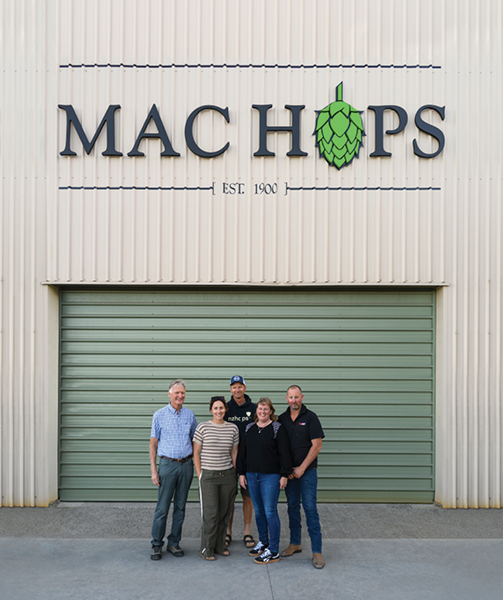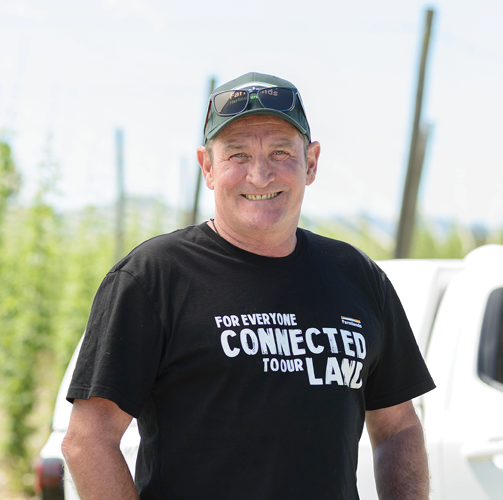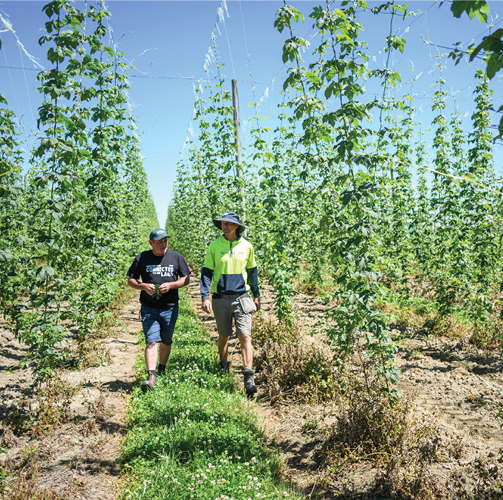

Riding the Hops Rollercoaster
The McGlashen family in the Tasman District are pioneers in New Zealand’s small hop-growing community. We spoke to Mac Hops director Brent McGlashen about the rewarding, and often challenging task of growing hops.
It’s a big year for the McGlashens, as they celebrate their 125th year in the hops business. When James McGlashen kicked things off in 1900 with a purchase of farmland near Motueka, Queen Victoria ruled Britain, the Ottoman Empire was still around, and the aeroplane had not yet been invented. The world has changed in many ways since then, but for fifthgeneration grower Brent, one of the most significant shifts in recent years has been in people’s beer-drinking habits. Had it not been for the craft beer revolution of the 2010s, he might have ended up in another line of work.
“When I came into the industry we were in a severe downturn, and down to only a few growers. It was a make-or-break year for our industry - we were in real strife. There wasn’t a lot of encouragement to go into hops in the early 2000s, then craft beer came along and hops became quite a snazzy thing to do.” Fast-forward to 2025 and hops growers are again under pressure during a tough economic climate and global hops surplus. Brent says the cost-of-living crisis is weighing on consumers’ minds and social calendars, which is having a flow-on effect for the beer industry. “People would love to go out on a Friday night but then they won’t have any money left to go out again the next Friday. The cost increases to craft brewers have been significant and they are doing their best to compete for consumers’ discretionary dollar spend.”

Cost Squeeze
Brent says the challenges faced by brewers and hops growers are global, not just in New Zealand. However, he is hopeful that changes in consumer behaviour will see continued support for craft brewers, and those like Mac Hops who supply them. “Quite a few people will, instead of reaching for a few bigger boxes of beer, grab a four-pack of craft beer and and share with their friends to discover new taste profiles to different beer styles they haven’t tried before.” The McGlashens have about 120ha of land growing hops across two sites, which have vastly different soil profiles despite being only a few kilometres apart. Brent says hops growing in Tasman is spread across a variety of soil types, giving the region versatility in what is grown.
“Different areas will give you a different oil profile, flavour and aroma,” he says. “Our home farm has got a sandy silt loam which is free draining, while our new farm 10-12 minutes’ drive away has Braeburn clay which is a gummier soil. “We’ve shifted some of our varieties from the home farm to the new farm, and vice versa, depending on which farm they were more suited to.” Tasman is New Zealand’s biggest hops growing region by far, and Brent says that is unlikely to change any time soon. Like Goldilocks sampling porridge, it seems hops need everything to be just right to thrive.
“Some are being trialled in places like Southland, Taranaki and Canterbury. You can grow hops probably anywhere else in New Zealand but you need to be economically viable,” Brent says. “The climate is the main thing - hops don’t like too much wind, and they like winter chilling but not too much frost at the wrong time; late Spring is not ideal. We farmers are always moaning about the weather - we can never flick the dial and say, ‘it’s okay’.”


Right Latitude
Luke Hawthorne, Farmlands’ Regional Sales Manager for Horticulture in the South, works closely with the Mac Hops team. He says latitude 41 is the “magic number” for hops. “If you look at regions where hops are grown along latitude 41, they perform exceptionally well,” Luke explains. “Hops are resilient—they’ll grow almost anywhere—but you don’t get the yields we achieve here in Tasman.” However, even with such favourable conditions, Luke stresses that growing hops isn’t easy. Timing, he says, is everything: “Get it wrong, and it can really set you back.”
Weed control, for example, plays a critical role in the hops-growing process. “Weeds compete with hop plants for nutrients, so spray timing is essential,” Luke says. “Because hops are a food crop, there are strict withholding periods. Everything has to be done precisely and on time— almost down to the day. Once you’ve cleared the ground for the hop plants, it’s all about managing fertiliser.” Hops are fast growers, and their sheer growth rate presents unique challenges. “They’re hungry plants,” Luke explains. “They can grow at least six inches a day—you can almost sit there and watch them grow.”
But rapid growth can backfire. “If hops grow too well, you end up with a big, bushy plant that won’t produce cones because it’s put all its energy into leaves. It’s a balancing act to ensure the right bines—stems—are trained up the string.” Compared to other crops, Luke says hops require fewer chemical inputs. “It’s mostly weed spraying and a bit of miticide. Mites are probably the biggest pest.”
Monitoring is critical to managing mites effectively. “We do a lot of ‘mite walking,’ where we monitor for predator mites to decide whether insecticide is necessary. We try to avoid using insecticides unless absolutely necessary. For predator mites like Zonda, we pick them up from the airport and deliver them straight to growers—they need to stay refrigerated.” When it comes to harvest, Luke says the process is a joy to watch but not for the faint-hearted. “The hours are relentless—enough to make even dairy farmers think twice. Many growers sleep in their packhouses during harvest, snatching just two or three hours of rest.”
Delicate Drying
The hops growing process is exhausting enough, but it’s just as important to get the drying process right, and that’s not easy either. Getting it wrong can not only affect the quality of the oil, but in extreme cases can even create a fire hazard. “Different varieties will dry at different times, and it takes expertise to become a consistent drier,” Brent says. “You don’t want to scorch them. You’re dropping down from between 75% and 77% moisture to between 9.5% and 11%, so you’re operating within a very specific parameter.” Brent has been drying hops for 20 years, and spent three seasons over in America in the Pacific Northwest before coming home to the family farm. He says he learned a lot from his time in the USA.
“Their farm was 15-20 times the size of our farm. We pale into the size of what they have. Their hops dry differently to what ours do. You can dry the petals out quickly but it’s the internals that need the right moisture. If it’s too dry you burn off the oils.” Brent is no stranger to long hours on the job, but he says the harvest isn’t necessarily the most difficult time of the year. “The mental side is harder in the growing season because you’ve got so many things to think about. When the crews are there to do the harvest, they just want to know which paddock to go into next.”


Labour Rotation
One of the biggest headaches for the horticulture sector around New Zealand is labour. Brent says hops growers in the Tasman region are fortunate to be part of a diverse rotation of horticulture work that allows people in the area to make it their full-time job. “The beauty of this Motueka area is there’s a lot of people who have made a success out of spending 9-10 months of the year on farms with several different farmers.” Peak hop growing labour needs slot in nicely with other local seasonal peaks. “They’ve got hop training for 6-8 weeks, then apple and kiwifruit thinning, a couple of weeks off late January/early February then hop harvest late February/March then apple picking, then pruning grapes, apples, kiwifruit and boysenberries.”
The Mac Hops team can swell to 60 staff during harvest time, and around 35-40 staff during the next busiest time of year, which is hop training (when the bines are wound on to lines to encourage them to grow upwards). For most of the year they have nine full-time staff. Brent says they wish they could offer more opportunities for young people entering the industry. “We want to bring some diversity into farming - we have a lot of young people coming through our doors. We love to teach them many practical skills and encourage them that farming is a great career opportunity.”
Brent says this is a problem across the rural sector, where succession planning is becoming more of a concern as the average age of farmers continues to rise. “It’s a tough period for farming because you’ve got a few of those older guys in limbo thinking ‘should I hold on for another year or two?’ There’s not a lot of farms being sold at the moment, and young people can’t afford to get into farming. “It’s not a good position for the sector to be in. Ten or fifteen years ago dairy did well because people could sharemilk and have a pathway to farm ownership. Now, people are looking up at a brick wall.”
All-in-One Job
For those looking to get into farming or growing, Brent says “stickability” is one of the most important attributes, as running a successful rural business requires much more than technical expertise. “You need to be a counsellor, wage clerk, accountant, a doctor if someone gets a cut… you’ve got to be all these things in one, while also knowing how to do soil analysis and fertiliser plans.” Brent gets plenty of help from the family. His dad Kim and his brotherin-law Owen Johnstone are also directors of Mac Hops and full-time, while Brent’s wife Ria manages HR and his sister Michelle Johnstone (Owen’s wife) is in charge of payroll.
The next generation of the family ranges in age from 5 to 18, and Brent says only time will tell whether they decide to continue with the family hops business. “There was never any pressure on me to do it.” As for the more immediate future, Brent expects the current tough economic conditions to continue for hops growers for a while yet. “We’re now having the typical commodity cycle of ugly peaks and nasty troughs. You get knee-jerk reactions when, after a good season, people suddenly oversupply and flood the market, but that’s out of our hands.” Given the economic climate, Brent says they have no expansion plans and are happy with what they’ve got now. “We’re already working a good 12-hour day and long weeks. We don’t need to get any bigger, we just need to start paying the bank back!”

